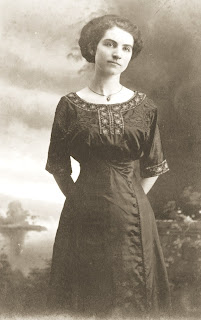The deeper I went into the trunk the more unsettling it became. Her writing was changing though the magazine photos of of beautiful women continued, the pictures changed to a handsome man in a smoking jacket smiling at the woman in a lovely dress, her hair coiffed to perfection and face made up to reflect a glow from a flickering fire in the fireplace. One after another following along the same theme of happy husband and attentive or coquettish woman smiling. Only now she was writing her name at the hem of each woman's dress. Alice was moving away from comparing herself to the magazine women, to becoming them. My best guess is that the clippings were from the early to mid 1930s. Mixed in with the ephemera of happy couples was a white paper sack filled with pamphlets and advertising directed solely to women. Each one pointed out a less than perfect part of a woman and offered solutions, salves and secrets to having clear bright skin, soft hands, greater vitality and elixirs for nervousness, hysteria, and disagreeable temperaments. Domesticity was to be taken in and embraced as the duty of the woman to provide a tranquil atmosphere. One thing I knew for sure was that if her household was anything like the one I lived in, it was anything but tranquil.
For Alice, her way to creating tranquility was to take her pharmacists suggestion and use Nervine. She was, as I'm sure he explained to her, a nervous woman and Nervine would bring a sense of calm to her system that would make her family situation more serene. Grandmother was one of heaven knows how many women across the country who dutifully took her spoonful of Nervine at least once a day. The poor woman needed all the help she could get. The men in my family are genetically predisposed to knocking the crap out anyone who ticked them off. Wives were prime targets for 'the rage' of a disgruntled man, ala 'she had it coming to her. I remember years later when she came to stay with us for a while that the Nervine was still with her. In her 60s by then she was already feeble and her eyes were clouded over. Nanau didn't track what was being said to her and she was just plain out of it. My child desire to want to know what was wrong followed me well into adulthood. I never forgot about the medicine and my grandmother's senility.
One day in an antique shop I found a collection of old medicine bottles. I learned Nervine had been outlawed decades ago. I read the label of ingredients and got my answer to my grandmother's mental and physical deterioration: she was an addict. The main ingredient in so many of the things given to women was phenobarbital, a barbiturate.







